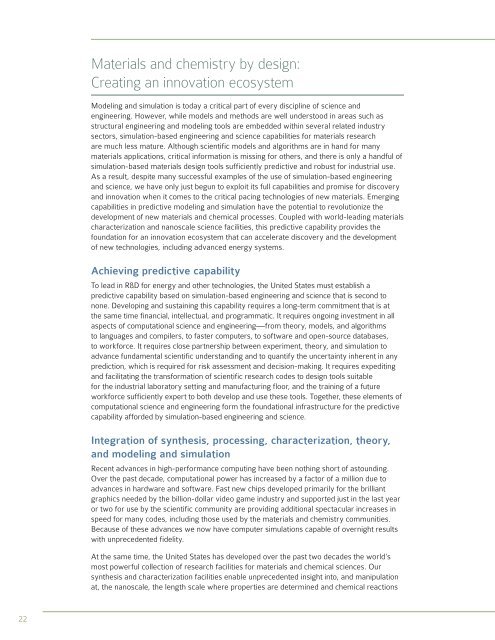Computational Materials Science and Chemistry ... - Office of Science
Computational Materials Science and Chemistry ... - Office of Science
Computational Materials Science and Chemistry ... - Office of Science
Create successful ePaper yourself
Turn your PDF publications into a flip-book with our unique Google optimized e-Paper software.
22<br />
<strong>Materials</strong> <strong>and</strong> chemistry by design:<br />
Creating an innovation ecosystem<br />
Modeling <strong>and</strong> simulation is today a critical part <strong>of</strong> every discipline <strong>of</strong> science <strong>and</strong><br />
engineering. However, while models <strong>and</strong> methods are well understood in areas such as<br />
structural engineering <strong>and</strong> modeling tools are embedded within several related industry<br />
sectors, simulation-based engineering <strong>and</strong> science capabilities for materials research<br />
are much less mature. Although scientific models <strong>and</strong> algorithms are in h<strong>and</strong> for many<br />
materials applications, critical information is missing for others, <strong>and</strong> there is only a h<strong>and</strong>ful <strong>of</strong><br />
simulation-based materials design tools sufficiently predictive <strong>and</strong> robust for industrial use.<br />
As a result, despite many successful examples <strong>of</strong> the use <strong>of</strong> simulation-based engineering<br />
<strong>and</strong> science, we have only just begun to exploit its full capabilities <strong>and</strong> promise for discovery<br />
<strong>and</strong> innovation when it comes to the critical pacing technologies <strong>of</strong> new materials. Emerging<br />
capabilities in predictive modeling <strong>and</strong> simulation have the potential to revolutionize the<br />
development <strong>of</strong> new materials <strong>and</strong> chemical processes. Coupled with world-leading materials<br />
characterization <strong>and</strong> nanoscale science facilities, this predictive capability provides the<br />
foundation for an innovation ecosystem that can accelerate discovery <strong>and</strong> the development<br />
<strong>of</strong> new technologies, including advanced energy systems.<br />
Achieving predictive capability<br />
To lead in R&D for energy <strong>and</strong> other technologies, the United States must establish a<br />
predictive capability based on simulation-based engineering <strong>and</strong> science that is second to<br />
none. Developing <strong>and</strong> sustaining this capability requires a long-term commitment that is at<br />
the same time financial, intellectual, <strong>and</strong> programmatic. It requires ongoing investment in all<br />
aspects <strong>of</strong> computational science <strong>and</strong> engineering—from theory, models, <strong>and</strong> algorithms<br />
to languages <strong>and</strong> compilers, to faster computers, to s<strong>of</strong>tware <strong>and</strong> open-source databases,<br />
to workforce. It requires close partnership between experiment, theory, <strong>and</strong> simulation to<br />
advance fundamental scientific underst<strong>and</strong>ing <strong>and</strong> to quantify the uncertainty inherent in any<br />
prediction, which is required for risk assessment <strong>and</strong> decision-making. It requires expediting<br />
<strong>and</strong> facilitating the transformation <strong>of</strong> scientific research codes to design tools suitable<br />
for the industrial laboratory setting <strong>and</strong> manufacturing floor, <strong>and</strong> the training <strong>of</strong> a future<br />
workforce sufficiently expert to both develop <strong>and</strong> use these tools. Together, these elements <strong>of</strong><br />
computational science <strong>and</strong> engineering form the foundational infrastructure for the predictive<br />
capability afforded by simulation-based engineering <strong>and</strong> science.<br />
Integration <strong>of</strong> synthesis, processing, characterization, theory,<br />
<strong>and</strong> modeling <strong>and</strong> simulation<br />
Recent advances in high-performance computing have been nothing short <strong>of</strong> astounding.<br />
Over the past decade, computational power has increased by a factor <strong>of</strong> a million due to<br />
advances in hardware <strong>and</strong> s<strong>of</strong>tware. Fast new chips developed primarily for the brilliant<br />
graphics needed by the billion-dollar video game industry <strong>and</strong> supported just in the last year<br />
or two for use by the scientific community are providing additional spectacular increases in<br />
speed for many codes, including those used by the materials <strong>and</strong> chemistry communities.<br />
Because <strong>of</strong> these advances we now have computer simulations capable <strong>of</strong> overnight results<br />
with unprecedented fidelity.<br />
At the same time, the United States has developed over the past two decades the world’s<br />
most powerful collection <strong>of</strong> research facilities for materials <strong>and</strong> chemical sciences. Our<br />
synthesis <strong>and</strong> characterization facilities enable unprecedented insight into, <strong>and</strong> manipulation<br />
at, the nanoscale, the length scale where properties are determined <strong>and</strong> chemical reactions

















